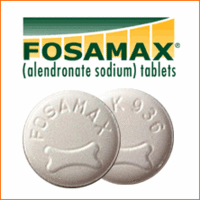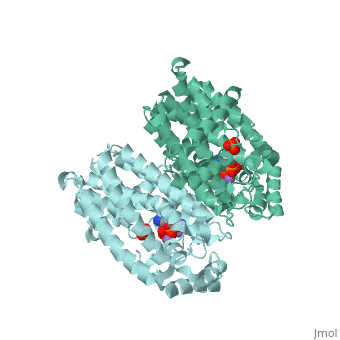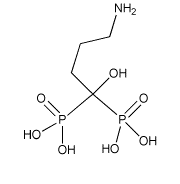Fosamax (alendronate sodium)
From Proteopedia
| Formula: | C4H13NO7P2 |
| Molar Mass: | 249.097 g/mol |
| INN: | Alendrotnic Acid |
| USAN: | Alendronate sodium |
| IUPAC: | 4-amino-1-hydroxybutylidene) bisphosphonic acid monosodium salt trihydrate |
Fosamax (Alendronate Sodium or Alendronic Acid) is a pharmaceutical drug administered as an antiresorptive therapy agent for osteodegenerative diseases such as Osteoporosis, Paget's disease, and osteogenesis imperfecta[1]. Functioning as a nitrogen-containing, second generation bisphosphonate, Fosamax binds to hydroxyapatite in bone and promotes apoptosis in osteoclasts (cells specialized in skeletal breakdown), thereby delaying the degradation of bone tissue. While incorporated in bone matrix, alendronate is not pharmacologically active, thus, it must be continuously administered to suppress osteoclasts on newly formed resorption surfaces [2].
Contents |
History [3]
Fosamax has been in use since September 29, 1995 after gaining Food and Drug Administration (FDA) approval. The drug obtained FDA clearance based on data from five clinical trials, lasting two years, involving 1,827 postmenopausal women with osteoporosis in 16 different countries. The trials showed a significant increase in bone mineral density at the spine, hip, and other sites. Overall, the drug reduced the number of women with new spinal fractures by 48%, the total number of new spinal fractures by 63%, and reduced overall height loss by 35%. Today, the drug remains in circulation in caplet and liquid forms and attainable at most pharmaceutical distribution centers with an eligible prescription.
Structural Highlights [4]
| |||||||||||
Mechanism of Action
Functioning as a nitrogen-containing, second generation bisphosphonate, Fosamax binds to hydroxyapatite in bone and promotes apoptosis in osteoclasts (cells specialized in skeletal breakdown), thereby slowing the degradation of bone tissue[5]. In order to accomplish this, Fosamax inhibits farnesyl pyrophosphate synthase (FPS or FPPS), one of the enzymes found in the mevalonic acid pathway, thereby reducing the production of isoprenoid compounds that are essential for post-translational modification of small guanosine triphosphate (GTP)-binding proteins (e.g. Rho, Ras, and Rab). By inhibiting FPS, Fosamax discourages the successive condensation of isopentenyl pyrophosphate with dimethylallyl pyrophosphate and geranyl pyrophosphate, which interferes with osteoclast function and survival [6][7].
Though the exact chemical mechanism by which alendronate inhibits FPPS remains unclear, nitrogen-containing bisphosphates (N-BPs) bind to the dimethylallyl/geranyl pyrophosphate (GPP/DMAPP) ligand pocket and alter the secondary structure of the enzyme[8]. Specifically, alendronate may bind to the FPPS allylic substrate-binding pocket by ligating the Magnesium ion center using phosphonate oxyanion, then inserting its amino group into the isoprenoid-binding pocket [9]. Phosphonate groups are stabilized by a cluster of three Mg2+ ions via oxyanion-metal cation charge interactions, as well as two FPS-conserved aspartate residues (ASP 117 and 121, Figure 3) that form a ligand-bisphosphonate chelate[10]. N-BPs may bind to the GPP substrate-binding site because N-BPs resemble the structure of the enzyme’s natural substrates (GPP and DMAPP) and act as carbocation transition state analogs. [11]. Interactions of the N-BP cyclic nitrogen with Threonine-201 and Lysine-200 suggest that these inhibitors function by positioning their nitrogen in the proposed carbocation-binding site, then mimicking the carbocation intermediate formed from substrate ionization [12]. By acting as an intermediate analog, Fosamax effectively increases the activation energy of a regulatory/rate-determining step in the mevalonate pathway, thereby reducing the concentration of certain molecules that aid the continuous breakdown of skeletal tissue.
Side Effects [13]
Common side effects of Fosamax include gas, constipation, heartburn, diarrhea, bloating, nausea, vomiting, stomach pain, joint pain or swelling, swelling in your hands or feet, dizziness, headache, eye pain, back pain, or weakness. Serious side effects of Fosamax include severe pain (joints, bone, muscle, jaw, back or heartburn), chest pain, difficulty swallowing, bloody stools, eye pain, skin blisters, and swelling of the face, tongue, or throat.
References
- ↑ Gong Li, Altman Russ B, Klein Teri E . "Bisphosphonates pathway" Pharmacogenetics and genomics (2011). from https://www.pharmgkb.org/pathway/PA154423660
- ↑ Fosamax: Uses, Dosage & Side Effects - Drugs.com. (2016, November 3).Fosamax: Uses, Dosage & Side Effects - Drugs.com. Retrieved November 14, 2016, from https://www.drugs.com/fosamax.html
- ↑ Fosamax (alendronate sodium). Fosamax New FDA Drug Approval | CenterWatch. Merck. Retrieved November 15, 2016, from http://www.centerwatch.com/drug-information/fda-approved-drugs/drug/26/fosamax-alendronate-sodium
- ↑ Protein Data Bank in Europe: Bringing Structure to Biology, from http://www.ebi.ac.uk/pdbe/entry/pdb/2F89
- ↑ Drake, Matthew T., Bart L. Clarke, and Sundeep Khosla. "Bisphosphonates: Mechanism of Action and Role in Clinical Practice." Mayo Clinic Proceedings 83, no. 9 (2008): 1032-045. doi:10.4065/83.9.1032.
- ↑ Alendronic acid. (2005, June 13), from http://www.drugbank.ca/drugs/DB00630#bond-15126
- ↑ Fisher, J. E., Rogers, M. J., Halasy, J. M., Luckman, S. P., Hughes, D. E., Masarachia, P. J., … Reszka, A. A. (1999). Alendronate mechanism of action: geranylgeraniol, an intermediate in the mevalonate pathway, prevents inhibition of osteoclast formation, bone resorption, and kinase activation in vitro. Proceedings of the National Academy of Sciences, 96(1), 133–138. doi:10.1073/pnas.96.1.133, from http://www.pnas.org/content/96/1/133.full.pdf
- ↑ Kavanagh KL, Guo K, Dunford JE, Wu X, Knapp S, Ebetino FH, et al. The molecular mechanism of nitrogen-containing bisphosphonates as antiosteoporosis drugs. Proceedings of the National Academy of Sciences. 2006;103:7829–34
- ↑ Hosfield DJ, Zhang Y, Dougan DR, Broun A, Tari LW, Swanson RV, et al. Structural Basis for Bisphosphonate-mediated Inhibition of Isoprenoid Biosynthesis. Journal of Biological Chemistry. 2003;279:8526–9
- ↑ Tarshis L. C., Yan M., Poulter C. D., Sacchettini J. C. Biochemistry. 1994;33:10871–10877. [PubMed]
- ↑ Martin M. B., Arnold W., Heath H. T., III, Urbina J. A., Oldfield E. Biochem. Biophys. Res. Commun. 1999;263:754–758. [PubMed]
- ↑ Martin, M. B., Arnold, W., Heath, H. T., III, Urbina, J. A., and Oldfield, E. (1999) Biochem. Biophys. Res. Commun. 263, 754–758
- ↑ Common Side Effects of Fosamax (Alendronate Sodium) Drug Center - RxList. (2015, August 26). RxList. Retrieved November 14, 2016, from http://www.rxlist.com/fosamax-side-effects-drug-center.htm
Contributors and Editors
Floro, Alyssa Jewel D. Kidd, Justin M. Samady, Osna M.



